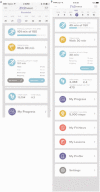User-centered development of a smartphone application (Fit2Thrive) to promote physical activity in breast cancer survivors
- PMID: 34398962
- PMCID: PMC8848993
- DOI: 10.1093/tbm/ibab112
User-centered development of a smartphone application (Fit2Thrive) to promote physical activity in breast cancer survivors
Abstract
Increased moderate and vigorous physical activity (MVPA) is associated with better health outcomes in breast cancer survivors; yet, most are insufficiently active. Smartphone applications (apps) to promote MVPA have high scalability potential, but few evidence-based apps exist. The purpose is to describe the testing and usability of Fit2Thrive, a MVPA promotion app for breast cancer survivors. A user-centered, iterative design process was utilized on three independent groups of participants. Two groups of breast cancer survivors (group 1 n = 8; group 2: n = 14) performed app usability field testing by interacting with the app for ≥3 days in a free-living environment. App refinements occurred following each field test. The Post-Study System Usability Questionnaire (PSSUQ) and the User Version Mobile Application Rating Scale (uMARS) assessed app usability and quality on a 7- and 5-point scale, respectively, and women provided qualitative written feedback. A third group (n = 15) rated potential app notification content. Quantitative data were analyzed using descriptive statistics. Qualitative data were analyzed using a directed content analysis. The PSSUQ app usability score (M1= 3.8; SD = 1.4 vs. M2= 3.2; SD = 1.1; lower scores are better) and uMARS app quality score (M1 = 3.4; SD = 1.3 vs. M2= 3.4; SD = 0.6; higher scores are better) appeared to improve in Field Test 2. Group 1 participants identified app "clunkiness," whereas group 2 participants identified issues with error messaging/functionality. Group 3 "liked" 53% of the self-monitoring, 71% of the entry reminder, 60% of the motivational, and 70% of the goal accomplishment notifications. Breast cancer survivors indicated that the Fit2Thrive app was acceptable and participants were able to use the app. Future work will test the efficacy of this app to increase MVPA.
Keywords: Exercise; Interventions; mHealth.
© Society of Behavioral Medicine 2021. All rights reserved. For permissions, please e-mail: journals.permissions@oup.com.
Figures
References
-
- Miller KD, Nogueira L, Mariotto AB, et al. . Cancer treatment and survivorship statistics, 2019. CA Cancer J Clin. 2019;69(5):363–385. - PubMed
-
- Kirshbaum MN. A review of the benefits of whole body exercise during and after treatment for breast cancer. J Clin Nurs. 2007;16(1):104–121. - PubMed
-
- Speck RM, Courneya KS, Mâsse LC, Duval S, Schmitz KH. An update of controlled physical activity trials in cancer survivors: a systematic review and meta-analysis. J Cancer Surviv. 2010;4(2):87–100. - PubMed
Publication types
MeSH terms
Grants and funding
LinkOut - more resources
Full Text Sources
Medical



